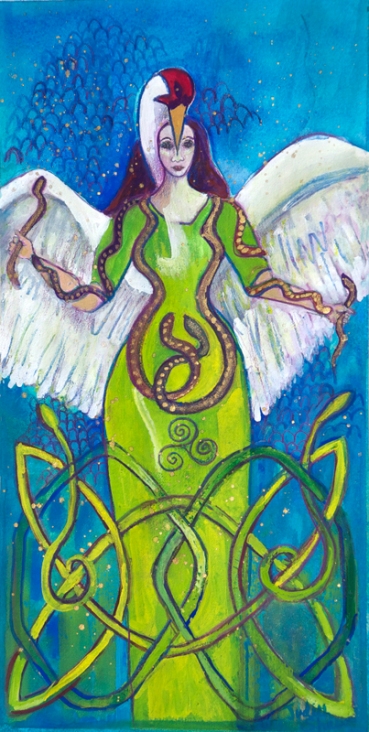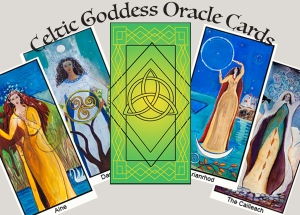 Even though snakes never inhabited Ireland, as in the rest of the ancient world both the serpent and the dragon were ancient symbols of life, fertility, wisdom and immortality for the Celts. Ancient Celtic ornamental work is entwined with serpents and dragons. The Celtic Knot can be seen as a never-ending serpent. A large stone with a carved serpent is found at the sacred cairn sites of Knowth. The megalithic structure of Brug na Bóinne (Newgrange) has multiple serpent-like spirals on the entrance stone.
Even though snakes never inhabited Ireland, as in the rest of the ancient world both the serpent and the dragon were ancient symbols of life, fertility, wisdom and immortality for the Celts. Ancient Celtic ornamental work is entwined with serpents and dragons. The Celtic Knot can be seen as a never-ending serpent. A large stone with a carved serpent is found at the sacred cairn sites of Knowth. The megalithic structure of Brug na Bóinne (Newgrange) has multiple serpent-like spirals on the entrance stone.
 In Scotland there is the earthen serpent at Glen Feochan, Loch Nell. The Pictish Aberlemno Serpent Stone is engraved with a serpent and other symbols. The torque collar, a symbol of kingship and status was created in the form of a hybrid horned dragon/snake. The serpent was connected to healing pools and springs and the Druids believed the serpent had healing powers together with a certain type of egg shaped stone called a “serpent’s egg.”
In Scotland there is the earthen serpent at Glen Feochan, Loch Nell. The Pictish Aberlemno Serpent Stone is engraved with a serpent and other symbols. The torque collar, a symbol of kingship and status was created in the form of a hybrid horned dragon/snake. The serpent was connected to healing pools and springs and the Druids believed the serpent had healing powers together with a certain type of egg shaped stone called a “serpent’s egg.”
The primal connection of Goddess to serpent to earth was alive all across the ancient world. Corra, the  Great Serpent Goddess of Ireland and Scotland, was probably there before the Milesians (the ancestors of the current day Celts) arrived. She was probably there before the Tuatha de Danaan arrived. Corra, whose name is almost forgotten today, embodied the Earth, calling forth the serpents of life, death and rebirth to twine the magic of eternity around the lives of our ancestors.
Great Serpent Goddess of Ireland and Scotland, was probably there before the Milesians (the ancestors of the current day Celts) arrived. She was probably there before the Tuatha de Danaan arrived. Corra, whose name is almost forgotten today, embodied the Earth, calling forth the serpents of life, death and rebirth to twine the magic of eternity around the lives of our ancestors.
Corra is of the earth and yet She can also transform into a crane, symbolizing the transformation of body to spirit on our journey through the great circle of life.
Her ancient stories are lost to us today. The only story that survives is the one in which St. Patrick kills Her and drives the snakes from Ireland. Since there were no snakes in Ireland this story is most certainly a mythopoetic one, illustrating the triumph of Christianity over the Old Religion, the Druids, and the worship of Corra.
In the story St. Patrick chases Corra all across Ireland to the final battle at Lough Derg. Lough Derg was an important religious site for the Old Religion with several islands in the lake. A prehistoric mound is visible on Station Island where today a Christian basilica and popular retreat sanctuary are prominent. The more northerly island, Saints Island, was the most important site of pilgrimage for the early Christians. It was a Purgatory Center and housed the original priory of the lake.


In one version of the story when Corra faced down St Patrick at Lough Derg She swallowed him whole. As Mircea Eliade noted in Rites and Symbols of Initiation, being swallowed by the snake can be seen as a return to the womb and – “a complete regeneration of the initiate through his gestation and birth by the Great Mother.”
St Patrick passed two days and two nights within Corra cutting his way out and killing her in the process. The water of the lake turned red with Her blood and Her body turned to stone. These stones were seen jutting out of the lake near to Saints Island and became part of the penitent experience of Purgatory.
The cave of the purgatory reflects yet another pagan association with the story. It corresponds to the long-practiced, Old European tradition of “incubation” or “temple sleep.” A far cry from purgatory where the dead go to suffer from their sins before being allowed into heaven, sacred caves were used by initiates to enter the Otherworld, meet their ancestors and gain knowledge and wisdom to bring back to a renewed life. Generally serpents were associated with these caves and with the initiation experience. The cave of St Patrick’s Purgatory might well have been a dream cave used in pagan initiation ceremonies. It might well have been a cave where worshippers of the Old Religion went to meet the Celtic Great Serpent Goddess, Corra, thus gaining wisdom and deep knowledge of the never-ending cycle of life.
Corra calls you to honor your place as a child of the Goddess, to rejoice in the beauty of physical life on Earth, to dive deep and then to surface and to accept the ever changing, transformative nature of life as you move through its cycles from birth to death to rebirth.
Sources: Goddess Alive, Croagh Patrick: Transforming the Green Serpent, The Irish Origins of Civilization, Symbol Dictionary
Judith’s deck of Celtic Goddess Oracle Cards is available now.  You can order your deck on Judith’s website – click herehttps://www.judithshawart.com/warehouse-originals-limited-editions-standard-products/original_art_products/oracle-and-books-2?product_gallery=359994&product_id=7087405. Experience the wisdom of the Celtic Goddesses!
You can order your deck on Judith’s website – click herehttps://www.judithshawart.com/warehouse-originals-limited-editions-standard-products/original_art_products/oracle-and-books-2?product_gallery=359994&product_id=7087405. Experience the wisdom of the Celtic Goddesses!
Judith Shaw, a graduate of the San Francisco Art Institute, has been interested in myth, culture and mystical studies all her life. Not long after graduating from SFAI, while living in Greece, Judith began exploring the Goddess in her artwork. She continues to be inspired by the Goddess in all of Her manifestations. Originally from New Orleans, Judith now makes her home in New Mexico where she paints as much as time allows and sells real estate part-time. Give yourself the gift of one of Judith’s prints or paintings, priced from $25 – $3000.


Serpents have fascinated me all my life. My mother feared them and I did too when I was very small but once the naturalist in me came to life I came to love all snakes even poisonous ones like the Mojave Rattlesnake I met last spring in the desert. Once out of striking distance I could admire his stunning attire! I first became fascinated by serpent lore in my thirties and now, reflecting back I see that the Great Serpent was calling me into relationship with the one I call the great goddess Nature. Serpents and women have been associates for millennia…so I am always delighted to read what someone else has learned about them.
LikeLike
Sara, I too love snakes while maintaining proper respect for the poisonous ones when crossing their path. We have a Snake “museum” (tourist shop) here in ABQ which houses a wide variety of southwest rattlers. They are all really beautiful though I do hate seeing animals in cages. I also have a fondness for spiders.
LikeLike
Glad to meet the great Serpent Goddess (who always seems to be pestered by prophets, saints, and knights and yet is still with us) by her Celtic or-older-than-Celtic name. Thank you for your stories and paintings!
LikeLiked by 1 person
It’s good to learn about Corra,and her relationship to the snake and the crane. As usual, your painting is wonderful. .
LikeLiked by 1 person
Thanks Barbara
LikeLike
A thousand of Thanks to you Judith Shaw for the sensual retouches.
20 years ago, the calls of the godesses have reached me.
The deep connectedness helped me to bring new forces into the world. <3
I'm so glad to find this email from wordpress in my inbox today.
Thought, for more than 6 weeks I don't visited the inbox; but since yesterday.
Wish you to feel etains shining soul in your aura – oh yey, I love your work <3
LikeLike
Hi Yvonne, So glad you opened your inbox and discovered my post. Blessed Be!
LikeLike
Hey Judith
Here is a link to the Celtic goddesses, 45 of A-S are briefly described. Also you can find a link to the work: Goddess Alive !: Inviting Celtic & Norse Goddesses into Your Life by Corey –
https://hubpages.com/religion-philosophy/Celtic-Goddesses
namastey Cécile
LikeLiked by 1 person